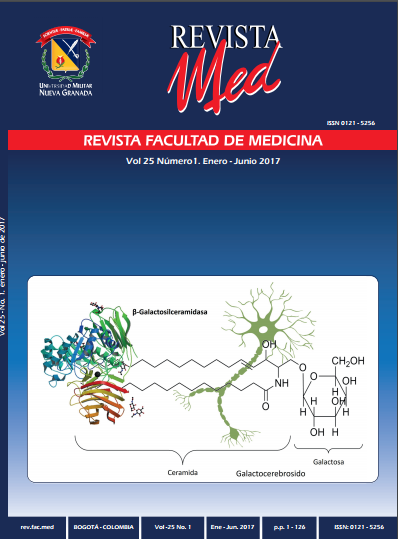Compromiso pulmonar en la enfermedad hepática: una actualización
Resumen
La enfermedad Hepática es una causa importante de morbilidad y Mortalidad en el mundo; asociada a compromiso orgánico múltiple. En el pulmón, tres condiciones clínicas han sido descritas; estos cuadros Incluyen, el Síndrome Hepatopulmonar (SHP), que obedece a un trastorno de la oxigenación por dilatación de la vasculatura pulmonar. La hipertensión portopulmonar (HPP), mediada por desequilibrio entre agentes vasodilatadores y vasoconstrictores que conducen a un aumento de la presión media de la arteria pulmonar y por último el Hidrotórax Hepático (HH), que es la condición menos prevalente, se fundamenta principalmente en anomalías anatómicas del diafragma, con o sin relación a la presencia de ascitis. La presencia SHP o HPP es predictor independiente de mortalidad, resaltando su importancia en la elegibilidad de pacientes para trasplante hepático ortotópico como medida curativa.
Descargas
Referencias bibliográficas
Moller, S., et al., Pathophysiological aspects of pulmonary complications of cirrhosis. Scand J Gastroenterol, 2007. 42(4): p. 419-27. https://doi.org/10.1080/00365520601151695
Swanson, K.L., R.H. Wiesner, and M.J. Krowka, Natural history of hepatopulmonary syndrome: Impact of liver transplantation. Hepatology, 2005. 41(5): p. 1122-9. https://doi.org/10.1002/hep.20658
D'Amico, G., G. Garcia-Tsao, and L. Pagliaro, Natural history and prognostic indicators of survival in cirrhosis: a systematic review of 118 studies. J Hepatol, 2006. 44(1): p. 217-31. https://doi.org/10.1016/j.jhep.2005.10.013
Rehm, J., A.V. Samokhvalov, and K.D. Shield, Global burden of alcoholic liver diseases. J Hepatol, 2013. 59(1): p. 160-8. https://doi.org/10.1016/j.jhep.2013.03.007
Scaglione, S., et al., The Epidemiology of Cirrhosis in the United States: A Population-based Study. J Clin Gastroenterol, 2014.
Sureka, B., et al., Thoracic perspective revisited in chronic liver disease. Gastroenterol Rep (Oxf), 2015. https://doi.org/10.1093/gastro/gov017
Montoya, A., et al., Caracterización epidemiológica de pacientes con cirrosis en una consulta de gastroenterología en Pereira, Colombia, 2009-2012. Rev Méd Risaralda, 2014. 20(2): p. 86-94.
Machicao, V.I., M. Balakrishnan, and M.B. Fallon, Pulmonary complications in chronic liver disease. Hepatology, 2014. 59(4): p. 1627-37. https://doi.org/10.1002/hep.26745
King, P.D., R. Rumbaut, and C. Sanchez, Pulmonary manifestations of chronic liver disease. Dig Dis, 1996. 14(2): p. 73-82. https://doi.org/10.1159/000171540
Sen, D.S. and D.G.J. Alexander, Pulmonary complications in liver disease. British Journal of Hospital Medicine, 2009. 70(12): p. 685-691. https://doi.org/10.12968/hmed.2009.70.12.45504
Kennedy, T.C. and R.J. Knudson, Exercise-aggravated hypoxemia and orthodeoxia in cirrhosis. Chest, 1977. 72(3): p. 305-9. https://doi.org/10.1378/chest.72.3.305
Raevens, S., et al., Hepatopulmonary syndrome and portopulmonary hypertension: recent knowledge in pathogenesis and overview of clinical assessment. Liver International, 2015. 35(6): p. 1646-1660. https://doi.org/10.1111/liv.12791
Grace, J.A. and P.W. Angus, Hepatopulmonary syndrome: update on recent advances in pathophysiology, investigation, and treatment. J Gastroenterol Hepatol, 2013. 28(2): p. 213-9. https://doi.org/10.1111/jgh.12061
Rodríguez-Roisin, R. and M.J. Krowka, Hepatopulmonary Syndrome — A Liver-Induced Lung Vascular Disorder. New England Journal of Medicine, 2008. 358(22): p. 2378-2387. https://doi.org/10.1056/NEJMra0707185
Schenk, P., et al., Prognostic significance of the hepatopulmonary syndrome in patients with cirrhosis. Gastroenterology, 2003. 125(4): p. 1042-52. https://doi.org/10.1016/S0016-5085(03)01207-1
Singh, C. and J.S. Sager, Pulmonary complications of cirrhosis. Med Clin North Am, 2009. 93(4): p. 871-83, viii. https://doi.org/10.1016/j.mcna.2009.03.006
Carter, E.P., et al., Regulation of heme oxygenase-1 by nitric oxide during hepatopulmonary syndrome. Am J Physiol Lung Cell Mol Physiol, 2002. 283(2): p. L346-53. https://doi.org/10.1152/ajplung.00385.2001
Zhang, H.-Y., et al., Intestinal endotoxemia plays a central role in development of hepatopulmonary syndrome in a cirrhotic rat model induced by multiple pathogenic factors. World Journal of Gastroenterology : WJG, 2007. 13(47): p. 6385-6395. https://doi.org/10.3748/wjg.v13.i47.6385
Thorens, J.B. and A.F. Junod, Hypoxaemia and liver cirrhosis: a new argument in favour of a "diffusion-perfusion defect". Eur Respir J, 1992. 5(6): p. 754-6.
Rodriguez-Roisin, R., et al., Pulmonary-Hepatic vascular Disorders (PHD). Eur Respir J, 2004. 24(5): p. 861-80. https://doi.org/10.1183/09031936.04.00010904
Mohammad Alizadeh, A.H., et al., Clinical features of hepatopulmonary syndrome in cirrhotic patients. World J Gastroenterol, 2006. 12(12): p. 1954-6. https://doi.org/10.3748/wjg.v12.i12.1954
Lv, Y. and D. Fan, Hepatopulmonary Syndrome. Digestive Diseases and Sciences, 2015. 60(7): p. 1914-1923. https://doi.org/10.1007/s10620-015-3593-0
Silverio Ade, O., et al., Are the spider angiomas skin markers of hepatopulmonary syndrome? Arq Gastroenterol, 2013. 50(3): p. 175-9. https://doi.org/10.1590/S0004-28032013000200031
Koch, D.G. and M.B. Fallon, Hepatopulmonary syndrome. Clin Liver Dis, 2014. 18(2): p. 407-20. https://doi.org/10.1016/j.cld.2014.01.003
Pascasio, J.M., et al., Prevalence and Severity of Hepatopulmonary Syndrome and Its Influence on Survival in Cirrhotic Patients Evaluated for Liver Transplantation. American Journal of Transplantation, 2014. 14(6): p. 1391-1399. https://doi.org/10.1111/ajt.12713
. Arguedas, M.R., et al., Utility of pulse oximetry screening for hepatopulmonary syndrome. Clin Gastroenterol Hepatol, 2007. 5(6): p. 749-54. https://doi.org/10.1016/j.cgh.2006.12.003
Poterucha, J.J., et al., Failure of hepatopulmonary syndrome to resolve after liver transplantation and successful treatment with embolotherapy. Hepatology, 1995. 21(1): p. 96-100. https://doi.org/10.1002/hep.1840210117
Gupta, S., D. Nayyar, and G. Pomier-Layrargues, Variability of oxygenation in possible hepatopulmonary syndrome: effects of requiring two abnormal arterial blood gas results for diagnosis. Dig Dis Sci, 2015. 60(6): p. 1848-55. https://doi.org/10.1007/s10620-014-3506-7
Hopkins, W.E., A.D. Waggoner, and B. Barzilai, Frequency and significance of intrapulmonary right-to-left shunting in end-stage hepatic disease. Am J Cardiol, 1992. 70(4): p. 516-9. https://doi.org/10.1016/0002-9149(92)91200-N
Rollan, M.J., et al., Value of contrast echocardiography for the diagnosis of hepatopulmonary syndrome. Eur J Echocardiogr, 2007. 8(5): p. 408-10. https://doi.org/10.1016/j.euje.2006.07.005
Surasi, D., P. Manapragada, and P. Bhambhvani, Lung perfusion imaging in hepatopulmonary syndrome using 99mTc macroaggregated albumin. Journal of Nuclear Cardiology, 2015. 22(3): p. 586-588. https://doi.org/10.1007/s12350-014-9990-5
Horvatits, T., et al., Von Willebrand factor antigen for detection of hepatopulmonary syndrome in patients with cirrhosis. J Hepatol, 2014. 61(3): p. 544-9. https://doi.org/10.1016/j.jhep.2014.04.025
Fallon, M.B., et al., Model for end-stage liver disease (MELD) exception for hepatopulmonary syndrome. Liver Transpl, 2006. 12(12 Suppl 3): p. S105-7. https://doi.org/10.1002/lt.20971
Iyer, V.N., et al., Hepatopulmonary syndrome: favorable outcomes in the MELD exception era. Hepatology, 2013. 57(6): p. 2427-35. https://doi.org/10.1002/hep.26070
Eshraghian, A., A.A.l. Kamyab, and S.K. Yoon, Pharmacological Treatment for Hepatopulmonary Syndrome. BioMed Research International, 2013. 2013: p. 670139.
Mantz, F.A., Jr. and E. Craige, Portal axis thrombosis with spontaneous portacaval shunt and resultant cor pulmonale. AMA Arch Pathol, 1951. 52(1): p. 91-7.
Simonneau, G., et al., Updated clinical classification of pulmonary hypertension. J Am Coll Cardiol, 2013. 62(25 Suppl): p. D34-41. https://doi.org/10.1016/j.jacc.2013.10.029
Cartin-Ceba, R. and M.J. Krowka, Portopulmonary hypertension. Clin Liver Dis, 2014. 18(2): p. 421-38. https://doi.org/10.1016/j.cld.2014.01.004
Aldenkortt, F., et al., Portopulmonary hypertension and hepatopulmonary syndrome. World Journal of Gastroenterology : WJG, 2014. 20(25): p. 8072-8081. https://doi.org/10.3748/wjg.v20.i25.8072
Kawut, S.M., et al., Clinical risk factors for portopulmonary hypertension. Hepatology, 2008. 48(1): p. 196-203. https://doi.org/10.1002/hep.22275
Krowka, M.J., Portopulmonary hypertension and the issue of survival. Liver Transpl, 2005. 11(9): p. 1026-7. https://doi.org/10.1002/lt.20494
Nayak, R., D. Li, and G. Matuschak, Portopulmonary hypertension. Current Gastroenterology Reports, 2009. 11(1): p. 56-63. https://doi.org/10.1007/s11894-009-0009-3
Dickinson, M.G., et al., The role of disturbed blood flow in the development of pulmonary arterial hypertension: lessons from preclinical animal models. Am J Physiol Lung Cell Mol Physiol, 2013. 305(1): p. L1-14. https://doi.org/10.1152/ajplung.00031.2013
Bosch, J., Vascular deterioration in cirrhosis: the big picture. J Clin Gastroenterol, 2007. 41 Suppl 3: p. S247-53. https://doi.org/10.1097/MCG.0b013e3181572357
Golbin, J.M. and M.J. Krowka, Portopulmonary hypertension. Clin Chest Med, 2007. 28(1): p. 203-18, ix. https://doi.org/10.1016/j.ccm.2006.11.004
Hoeper, M.M., M.J. Krowka, and C.P. Strassburg, Portopulmonary hypertension and hepatopulmonary syndrome. The Lancet, 2004. 363(9419): p. 1461-1468. https://doi.org/10.1016/S0140-6736(04)16107-2
Ratti, L. and M. Pozzi, The pulmonary involvement in portal hypertension: portopulmonary hypertension and hepatopulmonary syndrome. Gastroenterol Hepatol, 2006. 29(1): p. 40-50. https://doi.org/10.1016/s0210-5705(06)71595-3
Torregrosa, M., et al., Role of Doppler echocardiography in the assessment of portopulmonary hypertension in liver transplantation candidates. Transplantation, 2001. 71(4): p. 572-4. https://doi.org/10.1097/00007890-200102270-00015
Galiè, N., et al., Guidelines for the diagnosis and treatment of pulmonary hypertension. The Task Force for the Diagnosis and Treatment of Pulmonary Hypertension of the European Society of Cardiology (ESC) and the European Respiratory Society (ERS), endorsed by the International Society of Heart and Lung Transplantation (ISHLT). Vol. 30. 2009. 2493-2537.
Troy, P.J. and A.B. Waxman, Portopulmonary Hypertension: Challenges in Diagnosis and Management. Therapeutic Advances in Gastroenterology, 2009. 2(5): p. 281-286. https://doi.org/10.1177/1756283X09338431
Swanson, K.L. and M.J. Krowka, Arterial oxygenation associated with portopulmonary hypertension. Chest, 2002. 121(6): p. 1869-75. https://doi.org/10.1378/chest.121.6.1869
Krowka, M.J., et al., Improvement in pulmonary hemodynamics during intravenous epoprostenol (prostacyclin): A study of 15 patients with moderate to severe portopulmonary hypertension. Hepatology, 1999. 30(3): p. 641-8. https://doi.org/10.1002/hep.510300307
Makisalo, H., et al., Sildenafil for portopulmonary hypertension in a patient undergoing liver transplantation. Liver Transpl, 2004. 10(7): p. 945-50. https://doi.org/10.1002/lt.20153
Raevens, S., et al., Oral vasodilator therapy in patients with moderate to severe portopulmonary hypertension as a bridge to liver transplantation. Eur J Gastroenterol Hepatol, 2013. 25(4): p. 495-502. https://doi.org/10.1097/MEG.0b013e32835c504b
Hoeper, M.M., et al., Experience with inhaled iloprost and bosentan in portopulmonary hypertension. Eur Respir J, 2007. 30(6): p. 1096-102. https://doi.org/10.1183/09031936.00032407
Krowka, M.J., et al., Hepatopulmonary syndrome and portopulmonary hypertension: a report of the multicenter liver transplant database. Liver Transpl, 2004. 10(2): p. 174-82. https://doi.org/10.1002/lt.20016
Ashfaq, M., et al., The impact of treatment of portopulmonary hypertension on survival following liver transplantation. Am J Transplant, 2007. 7(5): p. 1258-64. https://doi.org/10.1111/j.1600-6143.2006.01701.x
Krowka, M.J., et al., Portopulmonary hypertension: a report from the US-based REVEAL Registry. Chest, 2012. 141(4): p. 906-15. https://doi.org/10.1378/chest.11-0160
Lazaridis, K.N., et al., Hepatic hydrothorax: pathogenesis, diagnosis, and management. Am J Med, 1999. 107(3): p. 262-7. https://doi.org/10.1016/S0002-9343(99)00217-X
Emerson, P.A. and J.H. Davies, Hydrothorax complicating ascites. Lancet, 1955. 268(6862): p. 487-8. https://doi.org/10.1016/S0140-6736(55)90269-5
Gur, C., Y. Ilan, and O. Shibolet, Hepatic hydrothorax--pathophysiology, diagnosis and treatment--review of the literature. Liver Int, 2004. 24(4): p. 281-4. https://doi.org/10.1111/j.1478-3231.2004.0936.x
Lieberman, F.L., et al., Pathogenesis and treatment of hydrothorax complicating cirrhosis with ascites. Ann Intern Med, 1966. 64(2): p. 341-51. https://doi.org/10.7326/0003-4819-64-2-341
Roussos, A., et al., Hepatic hydrothorax: Pathophysiology diagnosis and management. Journal of Gastroenterology and Hepatology, 2007. 22(9): p. 1388-1393. https://doi.org/10.1111/j.1440-1746.2007.05069.x
Haas, A.R. and M.S. Machuzak, Hepatic hydrothorax: current approaches to diagnosis and therapy. Techniques in Gastrointestinal Endoscopy, 2009. 11(3): p. 114-117. https://doi.org/10.1016/j.tgie.2009.06.008
Benet, A., et al., Diagnosis of hepatic hydrothorax in the absence of ascites by intraperitoneal injection of 99m-Tc-Fluor colloid. Postgraduate Medical Journal, 1992. 68(796): p. 153-153. https://doi.org/10.1136/pgmj.68.796.153
Malagari, K., et al., Cirrhosis-related intrathoracic disease. Imaging features in 1038 patients. Hepatogastroenterology, 2005. 52(62): p. 558-62.
Krok, K.L., Hepatic hydrothorax: Current concepts. Clinical Liver Disease, 2014. 4(2): p. 35-37. https://doi.org/10.1002/cld.375
Borchardt, J., et al., Treating hepatic hydrothorax. BMJ : British Medical Journal, 2003. 326(7392): p. 751-752. https://doi.org/10.1136/bmj.326.7392.751
Rodriguez-Panadero, F. and V.B. Antony, Pleurodesis: state of the art. Eur Respir J, 1997. 10(7): p. 1648-54. https://doi.org/10.1183/09031936.97.10071648
Lee, W.J., et al., Chemical pleurodesis for the management of refractory hepatic hydrothorax in patients with decompensated liver cirrhosis. Korean J Hepatol, 2011. 17(4): p. 292-8. https://doi.org/10.3350/kjhep.2011.17.4.292
Siegerstetter, V., et al., Treatment of refractory hepatic hydrothorax with transjugular intrahepatic portosystemic shunt: long-term results in 40 patients. Eur J Gastroenterol Hepatol, 2001. 13(5): p. 529-34. https://doi.org/10.1097/00042737-200105000-00011
Cerfolio, R.J. and A.S. Bryant, Efficacy of video-assisted thoracoscopic surgery with talc pleurodesis for porous diaphragm syndrome in patients with refractory hepatic hydrothorax. Ann Thorac Surg, 2006. 82(2): p. 457-9. https://doi.org/10.1016/j.athoracsur.2006.03.057
Rossle, M. and A.L. Gerbes, TIPS for the treatment of refractory ascites, hepatorenal syndrome and hepatic hydrothorax: a critical update. Gut, 2010. 59(7): p. 988-1000. https://doi.org/10.1136/gut.2009.193227
Krishnamoorthy, T.L., M. Taneja, and P.E. Chang, Symptomatic hepatic hydrothorax successfully treated with transjugular intrahepatic portosystemic shunt (TIPS)–role of titration of portosystemic gradient reduction to avoid post-TIPS encephalopathy. Clinical Case Reports, 2014. 2(3): p. 93-97. https://doi.org/10.1002/ccr3.70






.png)





